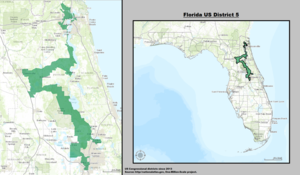| Florida's 5th congressional district | |
|---|---|
Interactive map of district boundaries since January 3, 2023 | |
| Representative | |
| Area | 3,911 [1] sq mi (10,130 km2) |
| Distribution |
|
| Population (2024) | 852,413 [3] |
| Median household income | $90,333 [3] |
| Ethnicity |
|
| Cook PVI | R+10 [4] |
Florida's 5th congressional district is a congressional district in the U.S. state of Florida. It includes the southeastern area of Jacksonville which comprises areas such as Arlington, East Arlington, Southside, Mandarin, San Jose, and the Beaches. It stretches south to St. Augustine in St. Johns County.
Contents
- Characteristics
- Court-ordered changes
- Recent election results from statewide races
- Composition
- List of members representing the district
- Election results
- 2002
- 2004
- 2006
- 2008
- 2010
- 2012
- 2014
- 2016
- 2018
- 2020
- 2022
- 2024
- References
From 2002 to 2013 the district comprised all of Citrus, Hernando, and Sumter counties and most of Lake, Levy, and Pasco counties and portions of Marion and Polk counties. The district included northern exurbs of Tampa and western exurbs of Orlando within the high-growth Interstate 4 Corridor. This iteration of the 5th district is now largely contained in the 11th district.
As defined by the state legislature in 2013 (which lasted until 2017), the 5th district ran from Jacksonville to Orlando; it was considered one of the most-gerrymandered congressional districts in the country. [5] Before 2013, similar territory was included in the 3rd district.
After court-mandated redistricting, the district became a majority-minority district from 2017 to 2023. It extended along Florida's northern boundary from Jacksonville to Tallahassee and included all of Baker, Gadsden, Hamilton and Madison counties and portions of Columbia, Duval, Jefferson, and Leon counties.
The district is currently represented by Republican John Rutherford.


















